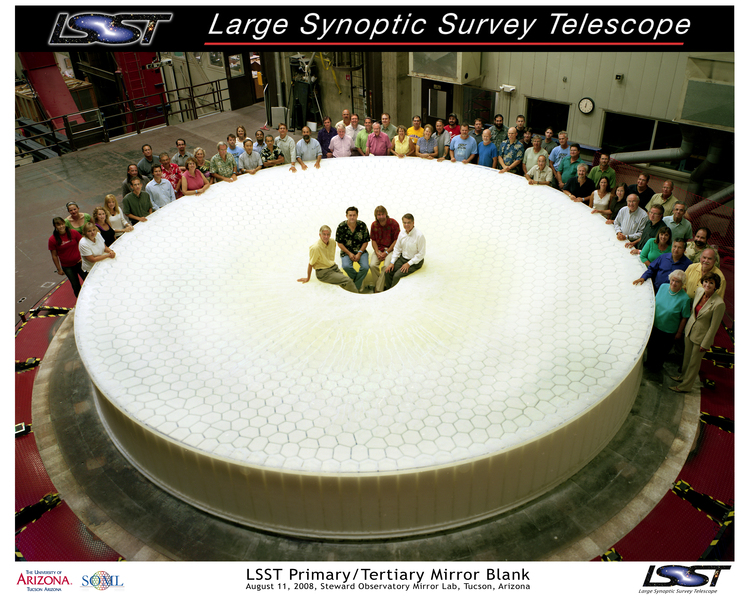The LSST, or the Large Synoptic Survey Telescope is a large survey telescope being constructed in northern Chile. When operational in 2015, it will be the widest, fastest, deepest eye of the new digital age, providing timelapse digital imaging across the entire night sky every three days, mapping the structure of our dynamic universe in three dimensions and exploring the nature of dark matter and dark energy. LSST hit a major milestone in its construction when the primary mirror blank was recently created. Project astronomers say the single-piece primary and tertiary mirror blank cast for the LSST is “perfect.”
The 51,900 pound (23,540 kg) mirror blank was fired in the oven at the University of Arizona’s Steward Observatory Mirror lab in Tucson, Arizona. It consists of an outer 27.5-foot diameter (8.4-meter) primary mirror and an inner 16.5-foot (5-meter) third mirror cast in one mold. It is the first time a combined primary and tertiary mirror has been produced on such a large scale.
LSST will have three large mirrors to give crisp images over a the largest field of view that will be available. The two largest of these mirrors are concentric and fit neatly onto a single mirror blank.
LSST was recently the recipient of two large gifts: $20 million from the Charles Simonyi Fund for Arts and Sciences, and $10 million from Bill Gates. The finished mirror is scheduled to be delivered in 2012.
News Source: LSST press release


Wow! Beautiful work!
that’s engineering!
I love those ‘segmented’ mirrors they do in Arizona. I wonder what Hubble woulda looked like if we had that technology back then ( … time really is damn relative …).
How much lighter is it they are compared to the standard method? I guess Hubble is as large as it could be when it had to go up on the shuttle. Ah well.
most cool.
How about a using our own sun’s gravitational lensing as the largest possible space telescope? I’m sure the focus points are way out there, but once our new generation of telescopes start to identify earthlike planets we could use these focus points to really “zoom in”. Just an idea…
Markus Demetrius –
Unfortunately – the sun is way to small and way to close to serve as a gravitational lens.
Incredible! I bet the physics/chemistry/engineering needed just to create the blank earned someone their PhD.
@Markus Demetrius and DaveM:
While the Sun DOES have a gravitational focus, it’s about 550 AU out (yes, “way out there”).
That’s a dozen times the distance to Pluto.
Furthermore, you will have multiple problems:
a) The sun is not a perfect sphere, so the gravitational focus plane is not a sphere either.
b) Too look at a target, you need to look exactly at the sun…
c) your target will be smeared into an Einstein Ring (if you do everything right). Not sure about the separation – but if you blot out the disc of the sun, your target will probably lie in the corona…
d) You traveled 550 AU, you look back – and you will see ONE tiny target area. To see an object a few degrees away, you’d have to travel a few tens of AU along an orbit.
e) I would assume any mass movements on the sun such as flares and prominences will introduce slight distortion in the images.
All in all, I deem this pretty impractical. An isolated solar mass black hole will serve you MUCH better.